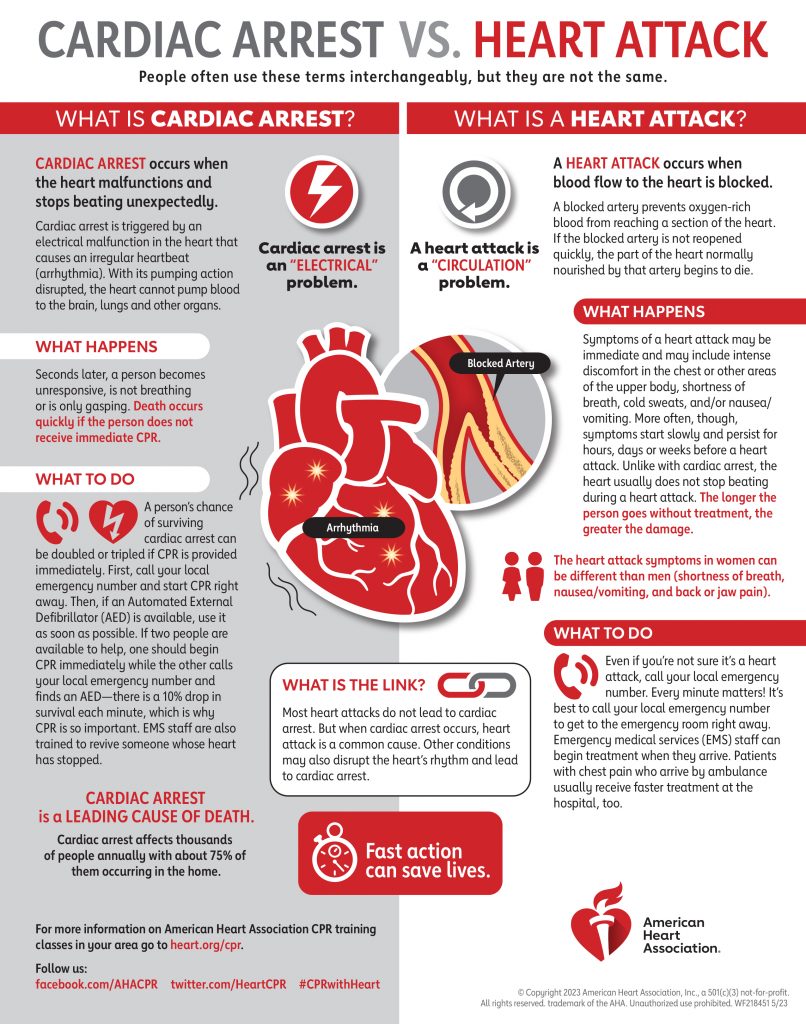
Bronny James, Damar Hamlin, Vince Iwuchukwu, Keyontae Johnson, Charlie Wyke: In recent years, young athletes have been in the news after surviving sudden cardiac arrest. Thirty years ago, Hank Gathers and Reggie Lewis were not as fortunate. While rare, these heart problems are scary for those affected and for spectators. For athletes and the general public, quickly recognizing cardiac arrest is crucial. Giving basic life support right away can be life-saving, limiting organ or brain injury. This includes cardio-pulmonary resuscitation (CPR) and automated external defibrillators (AEDs).
What is sudden cardiac arrest?
The heart moves blood and oxygen through the body. It supports vital organs like the brain and lungs. Sudden cardiac arrest is when with little to no warning the heart stops pumping blood. It is often related to an electrical or muscular problem with the heart. The American Heart Association (AHA) defines sudden cardiac arrest as a sudden loss of cardiac activity that leads to a person passing out with no signs of circulation. This is a medical emergency. A 2022 AHA study reports this happens to almost half a million people in the United States each year. Most cases happen outside of the hospital. Chances for survival are best when there are bystanders trained in CPR, an AED nearby, or medical professionals nearby. CPR (or just chest compressions alone) can keep enough blood going to vital organs. If needed, an AED can give a shock to get the heart rhythm back to normal. If CPR and/or an AED are used within minutes of a sudden cardiac arrest, the chances of living goes up a lot.
Related Stories
COMPLEXIONS Contemporary Ballet Premieres at Segerstrom
Gipson Promotes Mothers in Mourning March
Is this the same as a heart attack?
A heart attack (or myocardial infarction) happens when blood vessels to the heart are blocked. This causes heart muscle to start to die. It may form a scar later. Some heart attacks may lead to a cardiac arrest. Heart attack symptoms may include chest pain or pressure, shortness of breath, sweating, nausea, and vomiting. In order to save the heart muscle, people need treatment as soon as possible, ideally within hours of when the symptoms begin. Hospitals and emergency rooms can help right away to get the blood flow to the heart going. This may include medications that help the heart to recover.
What factors relate to cardiac arrest, and why does it affect young athletes?
Sudden cardiac arrest happens more commonly in older people and those with a history of heart disease. The chance of a healthy athlete having a cardiac arrest, ranges from 1 in 50,000 to 1 in 100,000 per year. However, athletes are more likely to have a cardiac arrest than non-athletes, so it’s important to have pre-participation physical exams and an understanding of family history of heart conditions or sudden death.
Most cardiac arrest cases in young athletes are because of abnormalities of the heart’s electrical system. This is often due to an undiagnosed genetic problem that affects the heart muscle or heart’s electrical system. During heat waves, athletes can die suddenly from dehydration and loss of electrolytes that put the heart at risk. However, for some athletes, a clear cause is not identified. Once an athlete has a cardiac arrest and recovers, there are strategies and treatments to prevent future events. For many, it is possible to return to sport activities after medical evaluation. There may seem to be more cases of cardiac arrest among Black male athletes, but researchers are still assessing the combined effect of related factors like sickle cell trait and underdiagnosis of heart conditions. The American College of Cardiology does not recommend extra screenings based on race or sport.
Many people are concerned about how COVID affects heart health. Viruses (including flu and the virus that causes COVID), can inflame and weaken the heart (otherwise known as myocarditis). Patients hospitalized with COVID have experienced both heart attacks and sudden cardiac death, possibly due to COVID-related damage to the heart and blood vessels. Despite misinformation that has been shared, COVID vaccines are safe and recommended for all those eligible. There has been a small, reported risk of myocarditis in young men who received the COVID vaccine. However, the symptoms were generally mild, and the risk of cardiac death is very low. Especially compared to the symptoms or the risk of cardiac death from a COVID infection.
Where can I learn more?
The AHA has resources related to bystander CPR and Hands-Only CPR, and can be found at https://cpr.heart.org/en/resources/bystander-cpr and https://cpr.heart.org/en/cpr-courses-and-kits/hands-only-cpr. If you see a cardiac arrest, Hands-Only CPR is an easy two-step skill that can save a life. Step 1 is to call 911. Step 2 is to push hard and fast in the middle of the chest at a rate of 100-120 times per minute (the equivalent of humming “Staying Alive” and pushing to the beat).
Nicholas Brownell, MD, and Boback Ziaeian, MD, PhD., are with the Division of Cardiology at David Geffen School of Medicine at UCLA.







